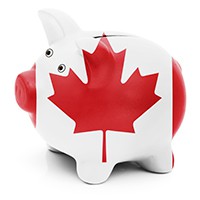Last updated: June 26 2018
Buy Canadian: But at What Cost?

It could be a “Buy-Canadian” summer as trade tensions escalating between Canada and U.S. are starting a movement towards economic nationalism throughout Canada. But that comes at a cost - can you afford to spend more? Canadians currently have over $2 Trillion in debt, according to the Bank of Canada, and increased spending could dig a deeper hole.
Canadians are voicing their support and intending to buy “homegrown” products, particularly when it comes to food. But, when buying many pre-packaged items that are strictly Canadian-made you can expect to spend more. Stretching your budget beyond its comfort zone could add to Canada’s debt problems, eliminating some of the economic benefits of purchasing with patriotism in mind.
On May 1, Governor Stephen Poloz outlined his concern about Canada’s existing debt problem during a speech to the Yellowknife Chamber of Commerce. “Debt,” he said, “is a tool that allows people to smooth out their spending throughout their life.” (But,) “high debt levels can make us vulnerable to negative events—individuals as well the entire economy.”
Furthermore, the Governor noted that there is little doubt that the economy is more sensitive to higher interest rates today, and that global and domestic interest rates are on the rise. Yet, because inflation appears to be in check, the opportunity successfully manage high debt levels appears to be good - if Canadians make smart financial decisions - at least for the foreseeable future.
In a report released on June 14, 2018, Statistics Canada provided data that supports the Governor’s statements:
- Households borrowed $22.2 billion in the first quarter, down from $25.4 billion in the previous quarter.
- Mortgage borrowing decreased $2.0 billion to $13.7 billion, the lowest level since the second quarter of 2014. This mirrored the 17.0 percent decrease in the value of residential resale activity in the first quarter, which also coincided with the introduction of new mortgage regulations and higher interest rates.
- Total household credit market debt (consumer credit, and mortgage and non-mortgage loans) totaled $2,134.3 billion in the first quarter.
- There was $1.68 in credit market debt for every dollar of household disposable income. But credit market debt as a proportion of household disposable income (adjusted to exclude pension entitlements) actually decreased from 169.7 percent in the fourth quarter to 168.0 percent, as disposable income increased at a faster rate (+1.3%) than credit market debt (+0.3%).
- And on what keeps Mr. Poloz up at night: mortgage interest payments (+3.7 percent) continued to outpace mortgage principal payments (-0.2 percent).
Ultimately, the choice to go “Trump-free” and buy Canadian with food and other purchases is an individual one, but it needs to be financially sustainable to be a benefit. Work with your financial advisor to evaluate your monthly family budget, and establish your priorities without it affecting your personal debt load.
Additional educational resources:
Looking for resources to help guide your clients’ financially sound decisions like these? Knowledge Bureau’s Debt and Cash Flow Management course can help. While you’re at it, increase your knowledge of cross-border taxation issues. Either by enrolling in the certificate course offered (a free trial is available!) or register to attend this year’s Distinguished Advisor Conference where economist Dr. Jack Mintz and other U.S. tax experts will be addressing the implications to Canada’s competitiveness and the tax consequences affecting Canadians.
COPYRIGHT OWNED BY KNOWLEDGE BUREAU INC. 2018.
UNAUTHORIZED REPRODUCTION, IN WHOLE OR IN PART, IS PROHIBITED.





